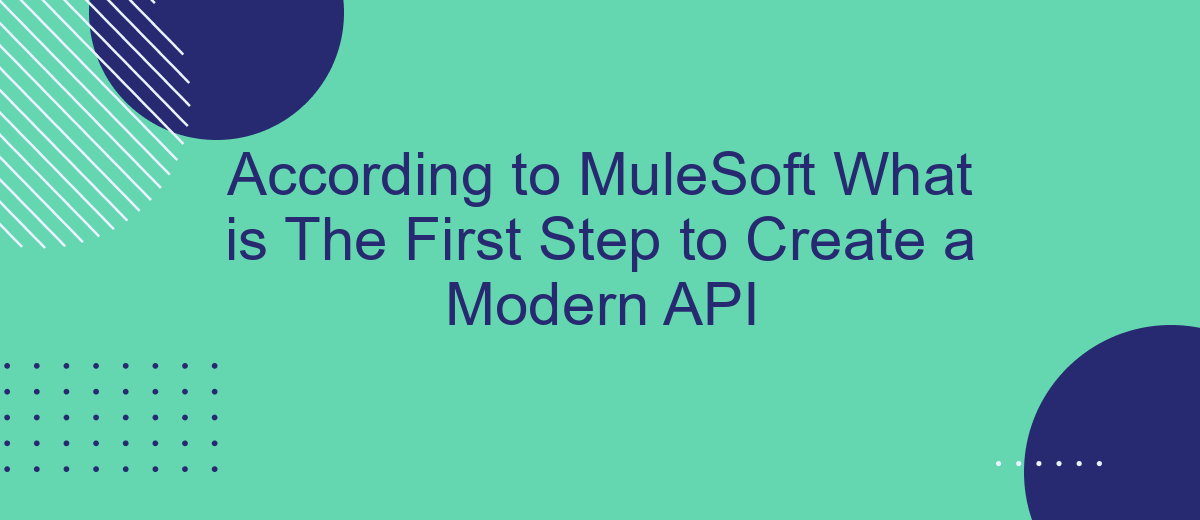Creating a modern API involves several crucial steps to ensure it meets the demands of today's digital landscape. According to MuleSoft, the first step in this process is to define the API's purpose and scope clearly. This foundational step sets the stage for a well-structured API that can efficiently serve its intended users and integrate seamlessly with other systems.
API Strategy and Governance
Creating a robust API strategy and governance framework is essential for modern API development. This involves setting clear guidelines and policies to ensure consistency, security, and scalability across all APIs. An effective strategy not only aligns with business goals but also facilitates seamless integration with various systems and services.
- Define API standards and protocols
- Implement security measures and compliance
- Establish versioning and lifecycle management
- Monitor and analyze API performance
- Facilitate integration with tools like SaveMyLeads for streamlined workflows
By adhering to these best practices, organizations can create APIs that are reliable, secure, and easy to manage. Tools like SaveMyLeads can significantly enhance the integration process, allowing for automated data transfer and reducing manual effort. This ensures that APIs not only meet technical requirements but also drive business efficiency and innovation.
Design and Build

Designing and building a modern API involves several crucial steps to ensure it meets the needs of both developers and end-users. The first step is to define the API's purpose and its target audience. This involves understanding the business requirements and the problems the API aims to solve. Once the purpose is clear, the next step is to design the API endpoints, data models, and methods. Tools like RAML or OpenAPI can be used to create a blueprint of the API. It is important to focus on creating a consistent and intuitive interface that adheres to RESTful principles or other architectural styles as needed.
After the design phase, the implementation process begins. This includes writing the code, setting up the necessary infrastructure, and integrating with other services. Utilizing integration platforms such as SaveMyLeads can streamline this process by automating data transfers between different applications, reducing development time and minimizing errors. Testing is a critical part of the build phase, ensuring the API functions as expected under various scenarios. Finally, thorough documentation should be provided to assist developers in understanding how to effectively use the API.
Secure and Manage

Securing and managing an API is crucial for maintaining its integrity and ensuring that only authorized users have access. Implementing robust security measures helps protect sensitive data and prevents unauthorized access. Moreover, managing an API effectively enables smooth operations and optimal performance.
- Implement authentication and authorization protocols to verify users and control their access levels.
- Use encryption to protect data both in transit and at rest, ensuring that sensitive information remains confidential.
- Monitor API usage and performance to detect and respond to potential threats or issues in real-time.
- Set rate limits to prevent abuse and ensure fair usage among all users.
- Regularly update and patch the API to address vulnerabilities and improve security features.
For seamless integration and management of various services, tools like SaveMyLeads can be invaluable. SaveMyLeads automates the process of connecting different applications, ensuring that data flows securely and efficiently between them. By leveraging such tools, you can enhance the security and manageability of your API, providing a reliable and secure experience for your users.
Connect and Deploy

Connecting and deploying an API is a critical step in ensuring seamless data flow and integration across various systems. This phase involves establishing secure connections between the API and other software environments, ensuring that data can be exchanged efficiently.
One of the key aspects of this process is choosing the right tools and platforms to facilitate integration. Platforms like MuleSoft offer robust solutions for connecting APIs to various applications and services, streamlining the deployment process.
- Identify the target systems for integration.
- Configure secure connections using appropriate protocols.
- Utilize integration tools like SaveMyLeads for automated workflows.
- Test the connections to ensure data integrity and security.
By leveraging platforms such as MuleSoft and SaveMyLeads, organizations can simplify the integration process, reducing the time and effort required to deploy APIs. These tools not only provide robust connectivity but also offer features for monitoring and managing data flows, ensuring a smooth and efficient deployment.
Operate and Monitor
Once your modern API is up and running, it is crucial to establish robust mechanisms for operation and monitoring to ensure its reliability and performance. Regular monitoring allows you to track the API's health, identify potential issues before they escalate, and optimize performance. Tools like MuleSoft's Anypoint Monitoring provide comprehensive insights into API usage, latency, and error rates, enabling teams to make data-driven decisions. Moreover, integrating services such as SaveMyLeads can streamline the process of connecting your API to various platforms, ensuring seamless data flow and reducing manual intervention.
Effective operation and monitoring also involve setting up automated alerts and notifications to promptly address any anomalies or performance degradation. By leveraging advanced analytics and real-time dashboards, teams can maintain a proactive stance, quickly responding to incidents and minimizing downtime. Additionally, implementing best practices like rate limiting, logging, and versioning can further enhance the stability and scalability of your API. Regular audits and updates ensure that your API remains secure and compliant with industry standards, providing a reliable and efficient service to your users.


FAQ
What is the first step to create a modern API according to MuleSoft?
Why is a specification-driven approach important in API design?
How can I ensure my API design is consistent and reusable?
What tools can help with API design and specification?
How can automation services benefit my API development process?
You probably know that the speed of leads processing directly affects the conversion and customer loyalty. Do you want to receive real-time information about new orders from Facebook and Instagram in order to respond to them as quickly as possible? Use the SaveMyLeads online connector. Link your Facebook advertising account to the messenger so that employees receive notifications about new leads. Create an integration with the SMS service so that a welcome message is sent to each new customer. Adding leads to a CRM system, contacts to mailing lists, tasks to project management programs – all this and much more can be automated using SaveMyLeads. Set up integrations, get rid of routine operations and focus on the really important tasks.
